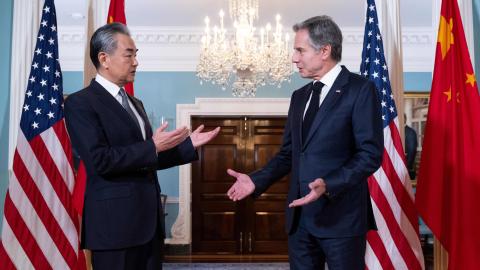We are living in a period of extraordinary and concurrent global security challenges: from the Indo-Pacific to Ukraine and the Middle East. These challenges, as often noted, extend well beyond the traditional domains of air, land, and sea, to cyber, space, supply chains and technology competition. At this pivotal moment, however, growing isolationist sentiment and significant divides in public opinion create a problematic environment in which to craft an appropriate grand strategy.
During the Cold War, for all the debate in the U.S. and among our allies over objectives, we had relatively focused grand strategy goals of foiling communism and limiting Soviet global aspirations. We tailored our strategies, which varied from containment in the Truman era, to Kennedy’s flexible response, to Reagan’s competitive strategies aimed at victory over communism.
In the U.S., we now recognize the China challenge but have yet to come to a common understanding of what a desired end-state with our principal strategic adversary might look like. Do we seek the defeat of the Communist Party as some have suggested, or a slightly more liberal China that more willingly complies with international norms? Or, as I would assert, a far weaker, less autocratic regime that might be more easily pressured not to harass its neighbors?
To put in place a grand strategy to effectively deal with the PRC, we need to have a clear definition of what our strategic objectives might look like – and then a clear sense of the means to achieve and manage it.
The competition with China is different from the Cold War, when our closest and most powerful allies in Europe were on the front line against the Soviet Union. Rather than a Soviet-style failing economy unable to meet basic consumer needs, China is a near-peer competitor willing to leverage broad international economic dependency, growing military prowess, increasing defense industrial base and cross-domain capabilities, while exerting greater control over internal information flows than the Soviet Union ever did. These challenges are compounded by the fact that the U.S. bears the overwhelming burden of deterrence in the Taiwan Strait and the First Island Chain – more complicated by geographic distance.
Our alliances in the Indo-Pacific are unlike those in the North Atlantic during the Cold War. Japan, the Philippines, the Republic of Korea, and Taiwan have made major security strides, especially in the past few years, as has Singapore. But potential support in the case of a Taiwan contingency from both the Philippines and the ROK, let alone Singapore, is more conditional because the fear of PRC economic retaliation weighs heavily. Other nations, such as Indonesia, Malaysia, and Thailand, are admittedly fence-sitters, who seem unwilling to meld their fate to that of Taiwan.
These complex strategic questions and the characteristics of our alliances in Asia are just a part of the broader subset of structural challenges affecting the formulation of American grand strategy. These challenges are profound – and extend well beyond the situation on the ground in the Indo-Pacific.
First, there are additional potential significant threats. While the PRC challenge is central to Taiwan and the First Island Chain, including Japan and the Philippines, we face an additional urgent security challenge posed by North Korea’s growing nuclear and missile programs.
While Russia’s war against Ukraine is the principal challenge in Europe, a broader threat to the Eastern flank of NATO, from the Baltics to the Balkans, remains. These challenges have been somewhat mitigated by Ukraine’s destruction of significant Russian military capabilities but Russia’s deep sense of grievance over Ukraine could well spill over into aggressive action elsewhere.
Simultaneously, Iran’s threat to America, Israel, and America’s Sunni allies -- exercised via proxy groups including the Houthis, Hezbollah, and Hamas, and through Iran’s expanding nuclear and ballistic missile programs -- has rarely been more serious.
These multi-theatre challenges are compounded by a growing alignment of interests between China, Russia, Iran, and the DPRK. China’s disruptive and illiberal opportunism, paired with Russia and Iran, has global implications, especially as these nations draw others to their vision of a splintered world, in a coalition of the “have-nots,” notably in Africa and Latin America, rejecting Western narratives and norms.
The grievances of the developing world have been firmly placed at the foot of the West by an anti-imperial, anti-colonial, and anti-capitalist ideology that conveniently ignores Russian, Chinese, and Iranian imperialism or the growing role of China as the largest global carbon emitter, the largest lender to the developing world, often at exorbitant interest rates, and a nation with territorial disputes with almost all of the countries which border it.
At the same time, the American electorate has rarely been more divided on fundamental issues as we are today, with deep implications for America’s global leadership. A significant number of Americans do not accept either American exceptionalism or the principles of the American Revolution – a result, in part, of the pernicious impact of culture relativism and anti-Western, post-colonial theories promoted, in part, by our strategic adversaries.
Part of the blame for the current crisis at our southern border can be placed on these ideologies, with a firm refusal of many in the United States to accept the primacy of the rule of law (seen in the outright rejection of the term “illegal alien”) or the critical importance of national borders as essential to national security. This crisis -- and the potential exploitation of our Southern border through foreign penetration – distracts from our capability to make strategic decisions away from our homeland, as the chorus of “money for our southern border not Ukraine” shows.
Lacking the confidence and unity needed to face complex strategic challenges and project power seems reinforced by the already existing American tendency towards isolationism. While our divisions and lack of strategic focus come to the fore, the major authoritarian nations have become more opportunistic and aligned, posing an ever more pervasive threat, and filling the vacuums we leave behind.
Paradoxically, in the Indo-Pacific, where American rhetoric is arguably less isolationist than elsewhere, our rhetorical focus on Taiwan, including those who speak of Taiwanese independence, often exceeds our willingness to commit resources. This, in turn, tends to drive away our allies (even in Taiwan) and fence-sitting nations who fear that certain American politicians may be as guilty as the PRC in promoting instability in the Taiwan Strait. We need to figure out how to talk about Taiwan in a more constructive manner, one that adheres more closely to the maxim of “walk softly but carry a big stick.”
Allies are critical to meeting the China challenge – especially in an era of American retrenchment -- and we need to recognize that we have much to learn from them. Japan, for instance, has unique credibility in the Indo-Pacific, especially in Southeast Asia, where Japanese development assistance and economic engagement have been essential, and a counterpoint to China’s Belt and Road Initiative. South Korea as well has unique credibility that is critical as we build the connectivity and relationships of trust that one day may enhance and extend our network of allies.
Simultaneously, our allies need to comprehend that while China’s aggression is most explicit in its near abroad, and focused on U.S. allies and partners who are the least well-suited to respond, the PRC’s ambitions are global, from its desire to assert greater control over international institutions to its attempt to gain control of major ports, its focus on controlling emerging technologies, especially in the green energy and EV markets, to its efforts at global information warfare and disinformation. China seeks to promote its autocratic vision of a splintered world in which it alone is strong enough to shape critical outcomes; it is willing to leverage all instruments of national power, from supply chains to cyber-threats, to public diplomacy, to achieve these ends.
The character of the Chinese challenge requires a multifold approach: a serious focus on our industrial base, technology, research, and development combined with strict economic security regulations and export controls aimed at denying the PRC key technologies. Simultaneously, we need to work with allies to develop future warfighting concepts and innovative technologies designed to assure our qualitative advantage.
We need to create an effective information campaign to explain to our public, our allies, and our enemies what we are seeking to achieve and why we need to dedicate precious resources to the PRC challenge. This public diplomacy challenge is especially difficult today, in part because the self-confidence and unity of the West has been undermined by the pernicious ideologies mentioned above.
Lastly, we need to extend these efforts to where China has made the greatest inroads – the so-called Global South. (It is too comprehensive a term, including nations that often have little in common, from relatively wealthy and well-governed ones such as Mauritius or Namibia, and others that are failing states, such as South Sudan.) Speaking abstractly about the liberal international order as do American and European elites does little to assuage deeply held grievances of the developing world, blamed, for better or worse, on the Global North.
Meeting this challenge requires an effort to build relations of trust with the developing world by promoting greater connectivity, whether through development assistance or private sector investment. Japan has already pointed the way to do this through its free and open Indo-Pacific strategy of engagement with Southeast Asia and Africa. On the public diplomacy side, we should look to our Quadrilateral Security Dialogue partner, India, which stakes a far greater claim to speak for the Global South than does China. Our interests and India’s are increasingly but not always aligned but we are far better off in a world in which the developing world follows India’s lead rather than China’s.















